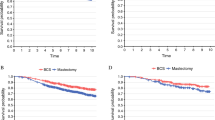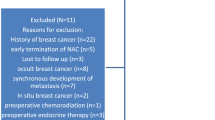Abstract
Purpose
Our previous study demonstrated breast-conserving surgery with radiation therapy (BCT) to be at least equivalent to mastectomy in T1-2N0-1 breast cancer. Yet, 10-year survival rates after BCT and mastectomy with radiation therapy (MAST) in T1-2N2 breast cancer specifically have not been examined. Our study aimed to determine 10-year overall (OS), relative (RS), and distant metastasis-free survival (DMFS) in T1-2N2 breast cancer after BCT and MAST, stratified for T category.
Methods
All women diagnosed with primary invasive T1-2N2 breast cancer in 2000–2004, treated with BCT or MAST, both with axillary dissection and RT, were selected from the Netherlands Cancer Registry. Ten-year OS and DMFS were estimated using multivariable Cox regression. Excess mortality ratios (EMR) were calculated to estimate RS, using life tables of the general population. OS and RS were determined on the whole cohort, and DMFS on the 2003 cohort with completed follow-up. Missing data were imputed.
Results
Of 3071 patients, 1055 (34.4 %) received BCT and 2016 (65.7 %) MAST. BCT and MAST showed equal 10-year OS and RS. After stratification, BCT was significantly associated with improved 10-year OS [HRadjusted 0.82 (95 % CI 0.71–0.96)] and RS (EMRadjusted 0.81 (95 % CI 0.67–0.97]) in T2N2, but not in T1N2. Ten-year DMFS was equal for both treatments [HRadjusted 0.87 (95 % CI 0.64–1.18)] in the 2003 cohort (n = 594), which was representative for the full cohort.
Conclusion
BCT showed at least equal 10-year OS, RS, and DMFS compared to MAST. These results confirm that BCT is a good treatment option in T1-2N2 breast cancer.




Similar content being viewed by others
Abbreviations
- BCSS:
-
Breast cancer-specific survival
- BCT:
-
Breast-conserving surgery with radiation therapy
- CI:
-
Confidence interval
- DMFS:
-
Distant metastasis-free survival
- EMR:
-
Excess mortality ratio
- HR:
-
Hazard ratio
- MAST:
-
Mastectomy with radiation therapy
- RCT:
-
Randomized controlled trial
- RS:
-
Relative survival
- RT:
-
Radiation therapy
- T category:
-
Pathologically staged tumor category (T1 = 0–2 cm, T2 = 2–5 cm)
References
Fisher B, Anderson S, Bryant J, Margolese RG, Deutsch M, Fisher ER, Jeong JH, Wolmark N (2002) Twenty-year follow-up of a randomized trial comparing total mastectomy, lumpectomy, and lumpectomy plus irradiation for the treatment of invasive breast cancer. N Engl J Med 347(16):1233–1241
Veronesi U, Cascinelli N, Mariani L, Greco M, Luini A, Aguilar M, Marubini E (2002) Twenty-year follow-up of a randomized study comparing breast-conserving surgery with radical mastectomy for early breast cancer. N Engl J Med 347(16):1227–1232
Van Dongen JA, Voogd AC, Fentiman IS, Legrand C, Sylvester RJ, Tong D, van der Schueren E, Helle PA, van Zijl K, Bartelink H (2000) Long-term results of a randomized trial comparing breast-conserving therapy with mastectomy: European Organization for Research and Treatment of Cancer 10801 trial. J Natl Cancer Inst 92(14):1143–1150
Hershman DL, Wright JD (2012) Comparative effectiveness research in oncology methodology: observational data. J Clin Oncol 30(34):4215–4222
van Maaren MC, de Munck L, de Bock GH, Jobsen JJ, van Dalen T, Linn SC, Poortmans P, Strobbe LJ, Siesling S (2016) 10 year survival after breast-conserving surgery plus radiotherapy compared with mastectomy in early breast cancer in the Netherlands: a population-based study. Lancet Oncol. doi:10.1016/S1470-2045(16)30067-5
Fisher S, Gao H, Yasui Y, Dabbs K, Winget M (2015) Survival in stage I-III breast cancer patients by surgical treatment in a publicly-funded healthcare system. Ann Oncol 26(6):1161–1169
Hofvind S, Holen A, Aas T, Roman M, Sebuodegard S, Akslen LA (2015) Women treated with breast conserving surgery do better than those with mastectomy independent of detection mode, prognostic and predictive tumor characteristics. Eur J Surg Oncol 41(10):1417–1422
Onitilo AA, Engel JM, Stankowski RV, Doi SA (2014) Survival comparisons for breast conserving surgery and mastectomy revisited: community experience and the role of radiation therapy. Clin Med Res 13(2):65–73
Chen K, Liu J, Zhu L, Su F, Song E, Jacobs LK (2015) Comparative effectiveness study of breast-conserving surgery and mastectomy in the general population: a NCDB analysis. Oncotarget 6(37):40127–40140
Fisher B, Bauer M, Wickerham DL, Redmond CK, Fisher ER, Cruz AB, Foster R, Gardner B, Lerner H, Margolese R et al (1983) Relation of number of positive axillary nodes to the prognosis of patients with primary breast cancer. An NSABP update. Cancer 52(9):1551–1557
NABON (2016). Dutch guideline breast cancer (Landelijke richtlijn mammacarcinoom). http://www.oncoline.nl/mammacarcinoom. Accessed 19 May 2016
Moossdorff M, van Roozendaal LM, Strobbe LJ, Aebi S, Cameron DA, Dixon JM, Giuliano AE, Haffty BG, Hickey BE, Hudis CA et al (2014) Maastricht delphi consensus on event definitions for classification of recurrence in breast cancer research. J Natl Cancer Inst 106(12):dju288
Gourgou-Bourgade S, Cameron D, Poortmans P, Asselain B, Azria D, Cardoso F, A’Hern R, Bliss J, Bogaerts J, Bonnefoi H et al (2015) Guidelines for time-to-event end point definitions in breast cancer trials: results of the DATECAN initiative (definition for the assessment of time-to-event endpoints in cancer trials). Ann Oncol 26(5):873–879
Hakulinen T, Seppa K, Lambert PC (2011) Choosing the relative survival method for cancer survival estimation. Eur J Cancer 47(14):2202–2210
Corazziari I, Quinn M, Capocaccia R (2004) Standard cancer patient population for age standardising survival ratios. Eur J Cancer 40(15):2307–2316
Narod SA (2012) Tumor size predicts long-term survival among women with lymph node-positive breast cancer. Curr Oncol 19(5):249–253
Skelly AC, Dettori JR, Brodt ED (2012) Assessing bias: the importance of considering confounding. Evid Based Spine Care J 3(1):9–12
Yin W, Di G, Zhou L, Lu J, Liu G, Wu J, Shen K, Han Q, Shen Z, Shao Z (2009) Time-varying pattern of recurrence risk for Chinese breast cancer patients. Breast Cancer Res Treat 114(3):527–535
Jatoi I, Tsimelzon A, Weiss H, Clark GM, Hilsenbeck SG (2005) Hazard rates of recurrence following diagnosis of primary breast cancer. Breast Cancer Res Treat 89(2):173–178
Dai Kubicky C, Mongoue-Tchokote S (2013) Prognostic significance of the number of positive lymph nodes in women with T1-2N1 breast cancer treated with mastectomy: should patients with 1, 2, and 3 positive lymph nodes be grouped together? Intl J Radiat Oncol Biol Phys 85(5):1200–1205
Henson KE, Jagsi R, Cutter D, McGale P, Taylor C, Darby SC (2016) Inferring the effects of cancer treatment: divergent results from early breast cancer trialists’ collaborative group meta-analyses of randomized trials and observational data from SEER registries. J Clin Oncol 34(8):803–809
Chavez-MacGregor M, Giordano SH (2016) Randomized clinical trials and observational studies: is there a battle? J Clin Oncol 34(8):772–773
Lee KJ, Carlin JB (2012) Recovery of information from multiple imputation: a simulation study. Emerg Themes Epidemiol 9(1):3
Covelli AM, Baxter NN, Fitch MI, Wright FC (2014) Increasing mastectomy rates-the effect of environmental factors on the choice for mastectomy: a comparative analysis between Canada and the United States. Ann Surg Oncol 21(10):3173–3184
Christante D, Pommier SJ, Diggs BS, Samuelson BT, Truong A, Marquez C, Hansen J, Naik AM, Veto JT, Pommier FR (2010) Using complications associated with post-mastectomy radiation and immediate breast reconstruction to improve surgical decision making. Arch Surg 145(9):873–878
Acknowledgments
We thank the Netherlands Cancer Registry for providing the data, and we thank the registration clerks for their effort in gathering data in the Netherlands Cancer Registry.
Author information
Authors and Affiliations
Corresponding author
Ethics declarations
Conflict of interest
The authors declare that they have no conflict of interest.
Ethical standards
This study complies with the current laws in the Netherlands.
Electronic supplementary material
Below is the link to the electronic supplementary material.
Rights and permissions
About this article
Cite this article
van Maaren, M.C., de Munck, L., Jobsen, J.J. et al. Breast-conserving therapy versus mastectomy in T1-2N2 stage breast cancer: a population-based study on 10-year overall, relative, and distant metastasis-free survival in 3071 patients. Breast Cancer Res Treat 160, 511–521 (2016). https://doi.org/10.1007/s10549-016-4012-8
Received:
Accepted:
Published:
Issue Date:
DOI: https://doi.org/10.1007/s10549-016-4012-8




